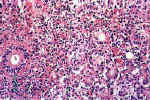| contents
| Mumps (epidemic parotitis) | 
|
| Mumps, or epidemic parotitis. is the most common of all salivary gland diseases. The name is traced back to mumps = grimace. In Dutch "mummelen, mompelen". The Dutch noun "bof" points to bouffer = bulging, while in French the epidemic swelling is called "oreillons" adnex to the ears. Its morbidity including meningitis and orchitis depends on the vaccination status and varies greatly in reports from the past ages. In about 50 percent of cases, clinical changes in the glands are absent. Where swelling is prominent, edema and a massive accumulation of lymphocytes and plasma cells compress the salivary duct, which may result in almost complete asialism. The diagnosis is made by detection of a rise in antibody titer by complement fixation after two estimations. Elevated values for serum and urine total amylase are consistently found. Differentiation of the isoamylases distinguishes between a rise due to parotid as opposed to pancreatic pathology. Sialography in mumps is not advocated. It shows compressed ducts, incidentally diffuse extravasation of the contrast medium. In sialochemistry the saliva shows a sharp increase in the sodium concentration and an exceptionally low potassium concentration, which approaches its plasma equivalents. Sodium values rise to 90-120 mmol/I while potassium values fall below 10 mmol/l. These high values are only to be compared with the changes found in Sjögren's syndrome, acute allergic (drug)reactions and following radiotherapy. Aberrant values may persist for months.
|
